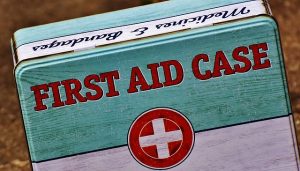Stress First Aid
 Stress First Aid (SFA) teaches individuals, either peer-to-peer or through leadership, how to identify stress in other individuals, in groups or teams or even at the organizational level, says Maria Lariccia Brennan, chief nursing officer (CNO) of Penn State Health St. Joseph Medical Center.
Stress First Aid (SFA) teaches individuals, either peer-to-peer or through leadership, how to identify stress in other individuals, in groups or teams or even at the organizational level, says Maria Lariccia Brennan, chief nursing officer (CNO) of Penn State Health St. Joseph Medical Center.
“Once you identify the level of stress, then it suggests actions that can be taken to deal with that level of stress and what strategies you might possibly use,” says Brennan, who in her previous position as a health care consultant to the New Jersey Nursing Initiative (NJNI), helped implement a statewide Nurse Stress First Aid program.
SFA’s Stress Continuum Model was first developed by the U.S. military for Navy and Marine Corps service members, according to the National Center for PTSD, to assess the level of their own and others’ stress responses. It has since been adapted for use by first responders and health care workers.
The model illustrates how stress reactions occur on a continuum. Early recognition of stress indicators allows nurses and nurse leaders to respond appropriately to de-escalate the stress reaction before they have the need for more formal intervention, the national center explains.
The Organization of Nurse Leaders, New Jersey, in which Brennan continues to be an active member, worked with NJNI, a Robert Wood Johnson Foundation program, to obtain the grant money to implement a nurse SFA program statewide.
“What’s nice about this program is it’s very user-friendly for the staff as well as leadership and what I also like about the program is we’re all speaking one language,” she says.
It’s easy for a nurse leader to step onto a floor, assess the tension level, and ask nurses what kind of day they’re having, she says.
Nearly half of New Jersey’s hospitals have adopted the program, Brennan says.
SFA uses the colors green, yellow, orange, and red, as a general framework for identifying stress levels in individuals.
Green means everything is proceeding smoothly, and the individual is in control, with optimal functioning. As stress builds, an individual may experience mild distress and feel irritable (yellow), severe and persistent distress (orange), and finally, stress causing life impairment (red).
SFA also is intended to help nurses recognize where their own stress level lies within the color coding for the purpose of self-care, but that’s usually easier said than done, Brennan says.
“Most of us, truthfully, are not good at that as nurses,” she says. “We tend to ignore our own personal stress because we’re so focused in on taking care of our patients or we’re worried about our families that we’re the last ones to deal with our own issues.”
But self-care is imperative for quality nursing, Brennan says.
The advantage of SFA is that it can be implemented in any health care environment—from large health systems to local first responder stations—and can include health care workers such as school nurses and home health nurses, Brennan says.
“It doesn’t have to be just for the acute care environment,” Brennan says. “The program is really the same, regardless of the healthcare environment that you’re in.”




